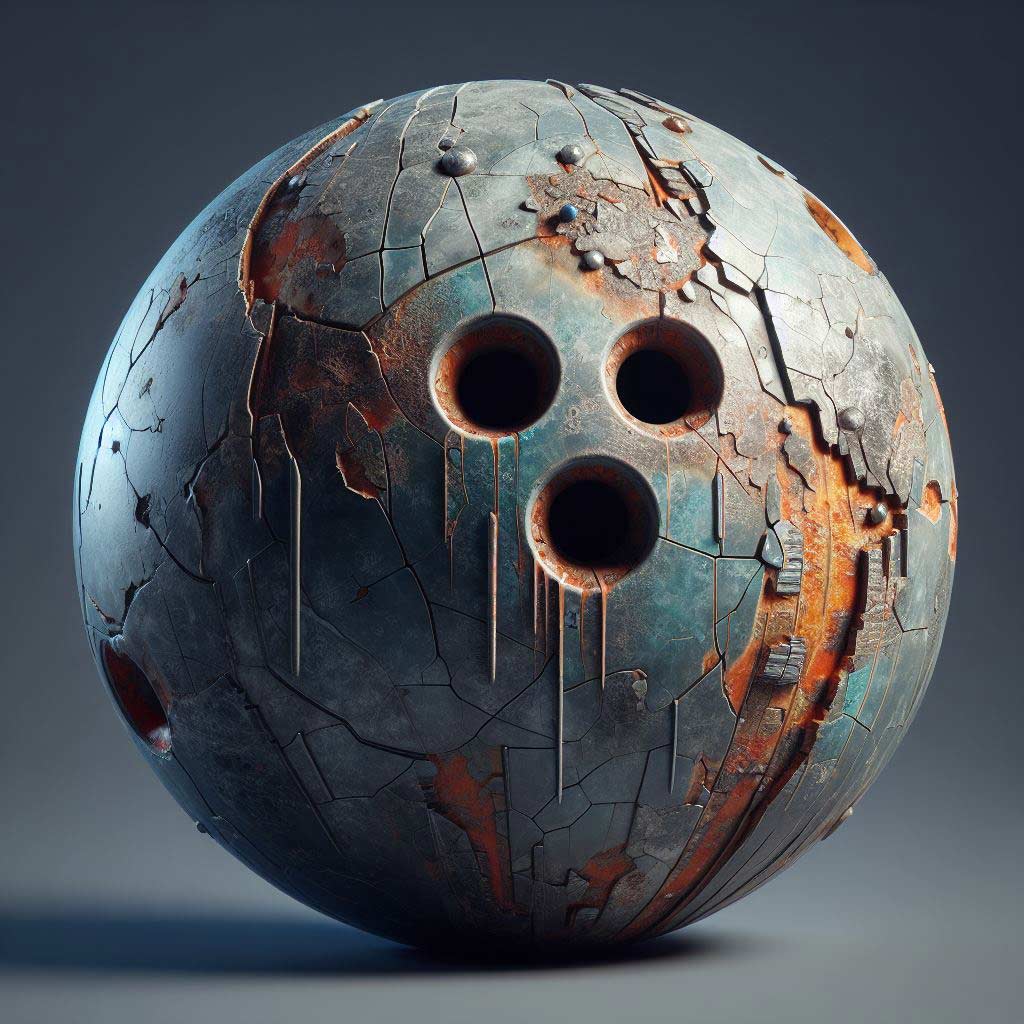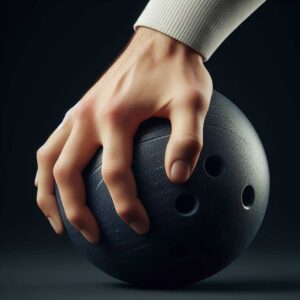As any experienced bowler knows, the ability to hook a bowling ball is a crucial skill that can significantly impact your performance on the lanes.
A well-placed hook shot allows you to generate more revolutions on the ball, leading to better pin carry and higher scores. However, what many bowlers may not realize is that a bowling ball’s hook potential is not a permanent feature – it can actually diminish over time due to various factors.
In this comprehensive guide, we’ll explore the reasons why a bowling ball can lose its hook, the signs to look out for, and the steps you can take to prevent or restore your ball’s hook potential.
Whether you’re a seasoned pro or a casual league bowler, understanding how to maintain your equipment is essential for consistent and high-scoring performance.
What Causes a Bowling Ball to Lose Its Hook?
There are several key factors that can contribute to a bowling ball losing its hook over time:
Wear and Tear on the Ball’s Coverstock
The coverstock of a bowling ball is the outer layer that directly interacts with the lane surface. This surface is designed to provide friction and grip, allowing the ball to hook and generate the desired backend reaction.
However, over extended use, the coverstock can become worn down, polished, or even damaged, reducing its ability to grip the lane effectively.
As the coverstock wears, the ball’s surface becomes smoother and more slick, decreasing the overall hook potential. This is particularly noticeable with urethane and reactive resin coverstocks, which are more susceptible to surface changes compared to solid plastic balls.
Changes in Oil Patterns on the Lane
The oil patterns applied to bowling lanes play a crucial role in determining how a ball will react and hook. Typically, heavier oil concentrations on the inner part of the lane will cause the ball to hook more, while lighter oil on the outside will result in a straighter ball path.
As the oil pattern changes over the course of a game or session, the ball’s hook potential can be significantly affected. For example, if the oil gets “pushed out” towards the gutters, the ball may lose some of its backend revolutions and hook less.
Improper Ball Maintenance and Cleaning
Proper ball maintenance is essential for preserving a bowling ball’s hook potential. Failing to clean and condition the coverstock regularly can lead to a buildup of contaminants, such as dirt, oil, and residue, which can diminish the ball’s ability to grip the lane.
Furthermore, using improper cleaning methods or harsh chemicals can actually damage the coverstock, accelerating the wear and tear process. This can result in a loss of hook, as the ball struggles to maintain its desired trajectory.
Changes in Grip and Release Technique
The way a bowler grips and releases the ball can also have a significant impact on its hook potential. Subtle changes in hand position, grip pressure, or release angle can alter the ball’s spin and rotational forces, leading to a decrease in overall hook.
For example, if a bowler develops a different or inconsistent release, the ball may not be imparting the same amount of revolutions, causing it to hook less. Additionally, any physical changes or adjustments to the bowler’s approach and delivery can also affect the ball’s performance.
Signs That a Bowling Ball Is Losing Its Hook
Recognizing the signs that a bowling ball is losing its hook potential is crucial for taking proactive measures to address the issue. Here are some of the key indicators to watch for:
Reduced Backend Reaction
One of the most noticeable signs that a bowling ball is losing its hook is a decrease in the backend reaction, or the ball’s ability to change direction sharply towards the pocket.
As the ball’s hook potential diminishes, you may observe the ball traveling straighter down the lane, with a less pronounced curve at the end of its path.
This reduced backend reaction can result in missed shots, poor pin carry, and an overall decrease in scoring potential.
Straighter Ball Path
In addition to a diminished backend reaction, a bowling ball that is losing its hook will also exhibit a more linear, straighter ball path down the lane. Instead of the classic “hook” shape, the ball’s trajectory may appear more direct, with less overall curve.
This change in ball motion can make it challenging to hit the desired target area and may require adjustments to your aim and release.
Less Overall Hook Potential
Beyond specific changes in the ball’s reaction, a general decrease in the overall hook potential is a clear sign that your bowling ball is losing its grip and revolutions.
This can manifest in a variety of ways, such as the ball failing to transition smoothly from the oil to the dry part of the lane, or a reduced ability to create the desired angle into the pocket.
If you find that your ball is consistently hooking less, regardless of the lane conditions or your approach, it may be time to address the underlying issue.
Preventing a Bowling Ball from Losing Its Hook
Proactively preventing your bowling ball from losing its hook potential is crucial for maintaining consistent performance and avoiding the need for costly repairs or replacements. Here are some key strategies to consider:
Proper Ball Maintenance and Cleaning
Regularly cleaning and conditioning your bowling ball’s coverstock is one of the most effective ways to preserve its hook potential. Use a high-quality ball cleaner and follow the manufacturer’s instructions to remove any built-up oil, dirt, or contaminants.
In addition to cleaning, consider applying a polish or conditioner to the ball’s surface to help maintain the desired level of friction and grip. This can help extend the life of the coverstock and prevent premature wear.
Resurfacing or Refinishing the Ball
Over time, even with proper maintenance, the coverstock of a bowling ball will inevitably begin to wear down and lose its hook potential. When this happens, consider having the ball professionally resurfaced or refinished.
This process involves removing the top layer of the coverstock and restoring the ball’s original surface characteristics, effectively “renewing” the hook potential. Professional ball drilling and pro shop services can provide this service, helping you keep your favorite ball in top condition.
Compensating for Changing Lane Conditions
As mentioned earlier, the oil pattern on the bowling lane can have a significant impact on a ball’s hook potential. To adapt to changing lane conditions, consider making adjustments to your approach, such as:
- Adjusting your target line or aiming point
- Changing the ball weight or surface characteristics
- Modifying your release angle or speed
- Experimenting with different ball layouts or drilling patterns
By being proactive and adapting your game to the lane conditions, you can help minimize the impact of oil pattern changes on your ball’s hook potential.
Adjusting Grip and Release Technique
If you notice that your bowling ball is losing its hook due to changes in your grip or release technique, take the time to address and correct these issues. This may involve:
- Consulting with a coach or pro shop professional to analyze your delivery
- Practicing new grip positions or release adjustments
- Gradually incorporating the changes into your regular gameplay
By maintaining consistent and proper technique, you can help ensure that your ball’s hook potential is not compromised by changes in your approach.
Restoring a Bowling Ball’s Hook
Despite your best efforts, there may come a time when your bowling ball’s hook potential has diminished to the point where it requires professional intervention. In these cases, there are several options available to help restore the ball’s desired performance.
Professional Ball Drilling and Resurfacing
One of the most effective ways to revive a bowling ball’s hook is to have it professionally drilled and resurfaced. This process involves removing the top layer of the coverstock and applying a new surface finish, effectively “renewing” the ball’s grip and hook potential.
Professional ball drilling services, often available at well-equipped pro shops, can evaluate the current state of your ball and recommend the appropriate resurfacing treatments. This may include services such as sanding, polishing, or applying a new reactive resin or urethane coating.
DIY Coverstock Restoration
For those who prefer a more hands-on approach, there are also DIY options for restoring a bowling ball’s hook potential. This can involve techniques such as:
- Using a ball resurfacing machine or sandpaper to remove the top layer of the coverstock
- Applying a ball polish or conditioner to revive the surface texture
- Experimenting with different cleaning solutions and methods to remove built-up contaminants
While DIY restoration can be a more cost-effective solution, it’s important to exercise caution and follow the manufacturer’s recommendations to avoid damaging the ball’s inner core or other components.
Testing and Evaluating the Ball’s Performance
Regardless of whether you opt for professional or DIY restoration, it’s crucial to thoroughly test and evaluate the bowling ball’s performance after the resurfacing process. This may involve:
- Conducting test shots on a variety of lane conditions
- Monitoring the ball’s hook potential, backend reaction, and overall trajectory
- Making adjustments to your release or approach as needed to adapt to the ball’s new characteristics
By carefully evaluating the ball’s performance, you can ensure that the restoration process has been successful and that the ball’s hook potential has been effectively restored.
When to Consider Replacing a Bowling Ball
While restoring a bowling ball’s hook potential can be a viable option, there may come a time when the ball is simply beyond repair or no longer meets your performance needs. In these cases, it may be necessary to consider replacing the ball entirely. Here are some signs that it’s time to invest in a new bowling ball:
Irreparable Damage to the Coverstock
If the bowling ball’s coverstock has sustained significant damage, such as deep gouges, cracks, or severe wear, it may be impossible to restore the ball’s original hook potential, even with professional resurfacing. In these cases, replacement is the best course of action.
Outdated or Obsolete Ball Technology
As bowling ball technology continues to evolve, older models may become less effective or unable to keep up with the demands of modern lane conditions and gameplay. If your current ball is several years old and no longer performing at the level you need, it may be time to upgrade to a newer, more advanced model.
Changes in Your Bowling Style or Needs
Over time, your bowling style or performance requirements may change, rendering your current ball less suitable for your needs. This could be due to factors such as:
- Improvements in your skill level and the need for a more specialized ball
- Changes in your physical capabilities, such as ball weight or grip size
- Shifting preferences for ball motion or overall performance characteristics
In these instances, replacing your bowling ball with one that better aligns with your current needs and abilities can help you maintain consistent and high-scoring performance.
Conclusion
Maintaining the hook potential of your bowling ball is essential for consistent and successful gameplay. By understanding the factors that can lead to a loss of hook, recognizing the signs, and taking proactive measures to prevent and restore your ball’s performance, you can ensure that your equipment remains a reliable and valuable asset on the lanes.
Whether it’s through proper maintenance, professional resurfacing, or ultimately replacing your ball, investing in the care and upkeep of your bowling equipment will pay dividends in the form of improved scores, higher confidence, and a more enjoyable overall bowling experience.
By applying the strategies and techniques outlined in this comprehensive guide, you can take control of your bowling ball’s hook potential and continue to dominate the lanes, one strike at a time.





